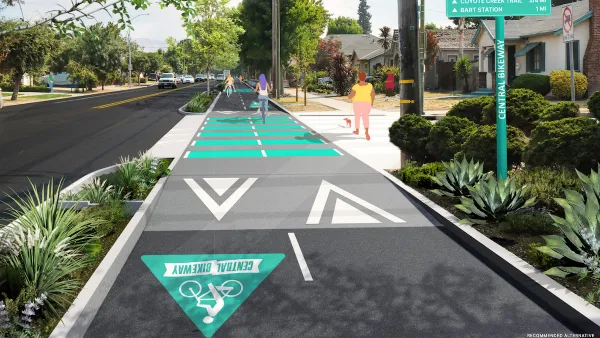Almost everyone complains about the traffic in Los Angeles. The city holds the dubious honor of being the most congested and polluted region in the country. UCLA urban planning professor and blogger Randall Crane grades wide range of solutions.
How did Los Angeles into this mess and what, if anything, can be done? Randall Crane examines the problems, outlines a wide range of historical and popular options to the problems, and finally, assigns a grade to each of the most likely solutions. The most likely solution may surprise you.
"...The short answer is that the region's economic success results in lots of people with lots to do. And, like people pretty much everywhere, they mostly do it by car. Southern California has the 10th largest economy in the world, containing 54% of California's jobs. On the other hand, the state has less road capacity than all but 2 of the 65 largest U.S. regions. Absent more roads, this strained capacity can be relieved only by substantially less driving per person, many fewer drivers, or both.
Either solution would be a neat trick.
...To begin, note that the reputation of Los Angeles as having extreme low density sprawl is an urban myth.
...Transportation planning used to be pretty easy, even in LA. The task was mainly to design streets and highways connecting concentrations of people (emerging towns) to where they wanted to go (jobs and commerce). In much earlier times, fixed rail and bus transit played dominant roles in these designs. However, the primary, almost exclusive, focus during the post-World War II era was to build street and highway systems to accommodate the most flexible and convenient mode, the car.
In doing so, planners reinforced patterns of urban and regional development that moved millions of residents and jobs away from the urban core to emerging centers throughout the region. It would be wrong to argue that freeways created the suburbs, but they worked hand in hand with a decentralized economic base, the rapid increase in women in the workforce (which complicates family commuting patterns and increases income availability for larger houses), the tax subsidy for home ownership, and the desire for a single-family home with a backyard.
...For most economists, the Holy Grail for traffic-related problems is charging drivers the costs (externalities) they impose on others. When forced to pay the real price of travel, some individuals would reduce their driving, share the cost through carpooling, and find other means of making trips. Unfortunately, imposing such a charge has not been politically feasible because drivers vehemently oppose paying for previously un-priced travel.
Each of the various solutions receive a grade by Randall Crane based on their potential to solve LA's traffic and pollution problems. A quick summary:
- Investment in road capacity: Grade: D
- Investment in and management of transit: Grade: C
- Congestion Pricing: Grade: D+
- Land use planning: Grade: B
Thanks to Randall Crane, via PLANET
FULL STORY: Los Angeles Traffic

Planetizen Federal Action Tracker
A weekly monitor of how Trump’s orders and actions are impacting planners and planning in America.

Silicon Valley ‘Bike Superhighway’ Awarded $14M State Grant
A Caltrans grant brings the 10-mile Central Bikeway project connecting Santa Clara and East San Jose closer to fruition.

Amtrak Cutting Jobs, Funding to High-Speed Rail
The agency plans to cut 10 percent of its workforce and has confirmed it will not fund new high-speed rail projects.

Oregon Approves Ambitious Framework for ’Microgrids’
Local energy “islands” within the larger power system ensure key facilities can remain online during emergencies and power outages.

A Historic Investment in LA County’s Parks and Open Spaces
Los Angeles County has launched its largest-ever competitive grant program, investing $58 million to expand park access, enhance climate resilience, and support community-driven projects in the areas that need them most.

San Diego Wins $14M for Affordable Housing
The funding comes via the state’s Regional Early Action Planning program and will help create close to 1,000 new housing units.
Urban Design for Planners 1: Software Tools
This six-course series explores essential urban design concepts using open source software and equips planners with the tools they need to participate fully in the urban design process.
Planning for Universal Design
Learn the tools for implementing Universal Design in planning regulations.
Caltrans
City of Fort Worth
New Jersey Institute of Technology
Mpact (founded as Rail~Volution)
City of Camden Redevelopment Agency
City of Portland
City of Laramie


























